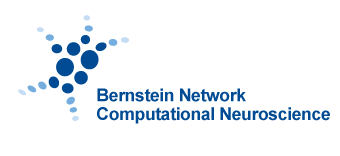How jellyfish swim: HU study explains the interaction between neural networks and muscle activation
From the biophysical properties of individual cells to the movement of the entire body, a study at Humboldt-Universität explains how jellyfish control their locomotion.

This 3D model of the hydrozoan jellyfish features its motor nerve net in yellow. The nerve net consists of electrically coupled motor neurons arranged in two rings connected via four radial branches. Fabian Pallasdies and colleagues from the Institute of Biology at Humboldt-Universität zu Berlin (HU) developed a biophysical model of the motor nerve net, linking its activity to a biomechanical fluid simulation in order to understand how the jellyfish achieves stable and efficient swimming motion. Picture: Emily Lowes/ https://emilylowes.com/medical-art
Bernstein member involved: Susanne Schreiber
Aquatic animals need tightly choreographed movements to efficiently navigate through open waters. Jellyfish, which swim forward by contracting and ejecting water with their bell-shaped body, must also respond to sensory stimuli on their outer skin to initiate hunting or escape. How they use their simple neural networks to activate muscles is not yet fully understood.
Using a mathematical model, Fabian Pallasdies and colleagues from Prof. Dr. Susanne Schreiber’s Theoretical Neurophysiology working group at the Institute of Biology at Humboldt- Universität zu Berlin (HU) have now investigated the coupling of neural activity and motor response in these swimming movements. In their study, published in the Journal of Neuroscience, they reveal the sophisticated temporal interaction between nerve and muscle cells that enables rapid muscle contraction, allowing jellyfish to swim stably in a given direction. The study provides a rare example of a complete mechanistic explanation of animal behaviour – from the biophysical properties of individual cells to the movement of the entire body.
Combination of nerve, muscle and fluid-mechanical simulation
For their study, the researchers used a mathematical model that not only simulates the electrical activity of the nerve and muscle system of the Hydrozoan jellyfish, but also the bell-shaped body of the animal and how it interacts with the water while swimming. This combination of nerve, muscle and fluid-mechanical simulation showed that it is the rapid, symmetrical muscle contraction in particular that stabilises jellyfish when swimming. The simulation also reveals how muscle contraction is achieved: When the jellyfish is stimulated at any point on its body, the ring-shaped muscle strands running around the body contract to expel water out of the area enclosed by the jellyfish’s body and thus swim forward. To do this, the muscle ring is electrically activated. This is achieved by the nerve ring, in which the electrical activity first spreads and then stimulates the connected muscle cells.
But how do nerve and muscle cells work together to achieve the necessary speed of muscle contraction? ‘In the simplest case, the electrical activity would spread in one direction once around the entire ring,’ says Susanne Schreiber, who leads the working group. ‘But then the contraction would take too long, and the jellyfish would start to tumble.’ Even if the electrical activity were to move in two directions simultaneously from the stimulation point, thereby halving the time it takes to activate the muscles, the simulations showed that this would not be sufficient to stabilise the swimming movements.
Elegant activation mechanism enables rapid muscle contraction
In their study, the researchers reveal that jellyfish use an elegant principle to significantly reduce the time it takes for muscles to contract: the electrical activity spreads from the stimulation point in the nerve ring in two directions. Initially, this activity of the nerve cells is still too weak to stimulate the muscles. Only as it spreads do the electrical pulses in the nerve ring synchronise and become strong enough to ‘ignite’ the muscle cells. As a result, four waves of activity now moves through the muscle ring (from both ignition points in both directions). This reduces the total time it takes for all muscles in the ring to be activated to about a quarter. In addition, muscle activation is more symmetrical and thus facilitates stable movement in one direction.
‘The simulation of the jellyfish’s swimming movement proves that stable swimming is only possible with a neuro-muscular coupling that supports this fourfold propagation principle,’ says Schreiber. The study also shows how important it is to consider the direct relationship between the properties of individual nerve cells, muscle cells and the behaviour of the animal in its natural environment. ‘In animals with less complex nervous systems, such as jellyfish, this is now possible thanks to mathematical simulation, allowing us to discover mechanisms by which nerve cells and their properties have a direct effect on behaviour.’





